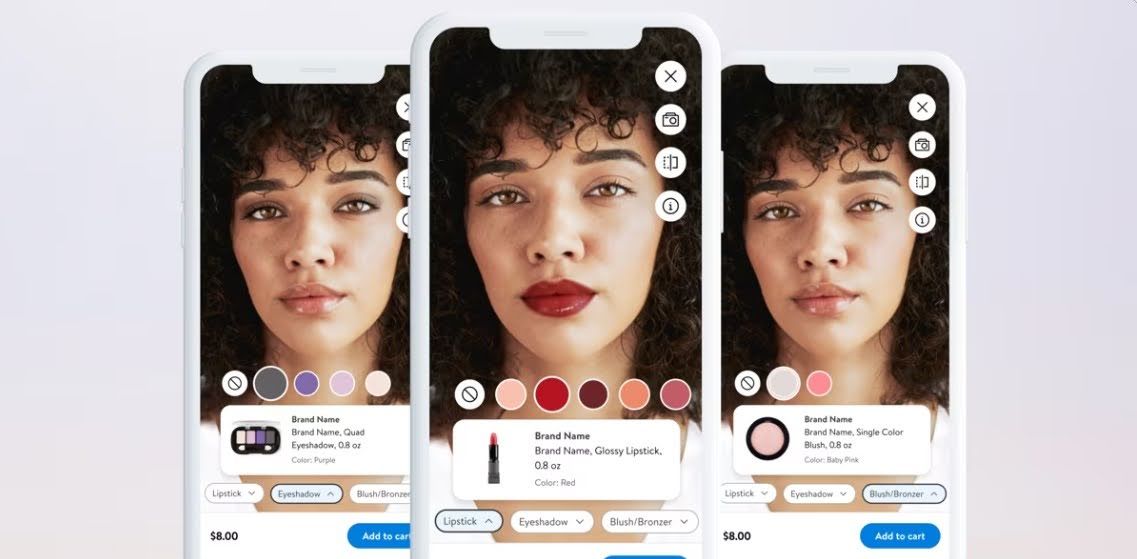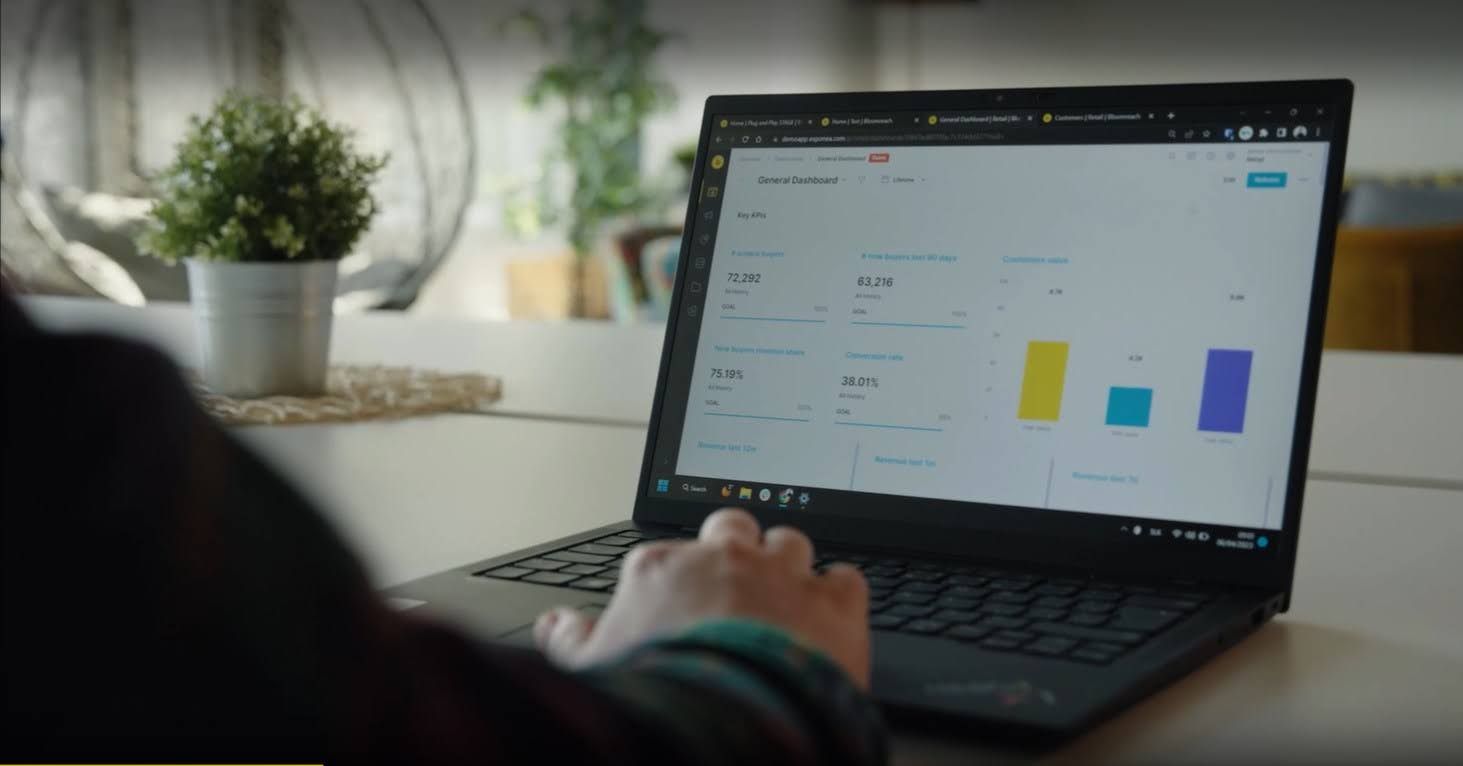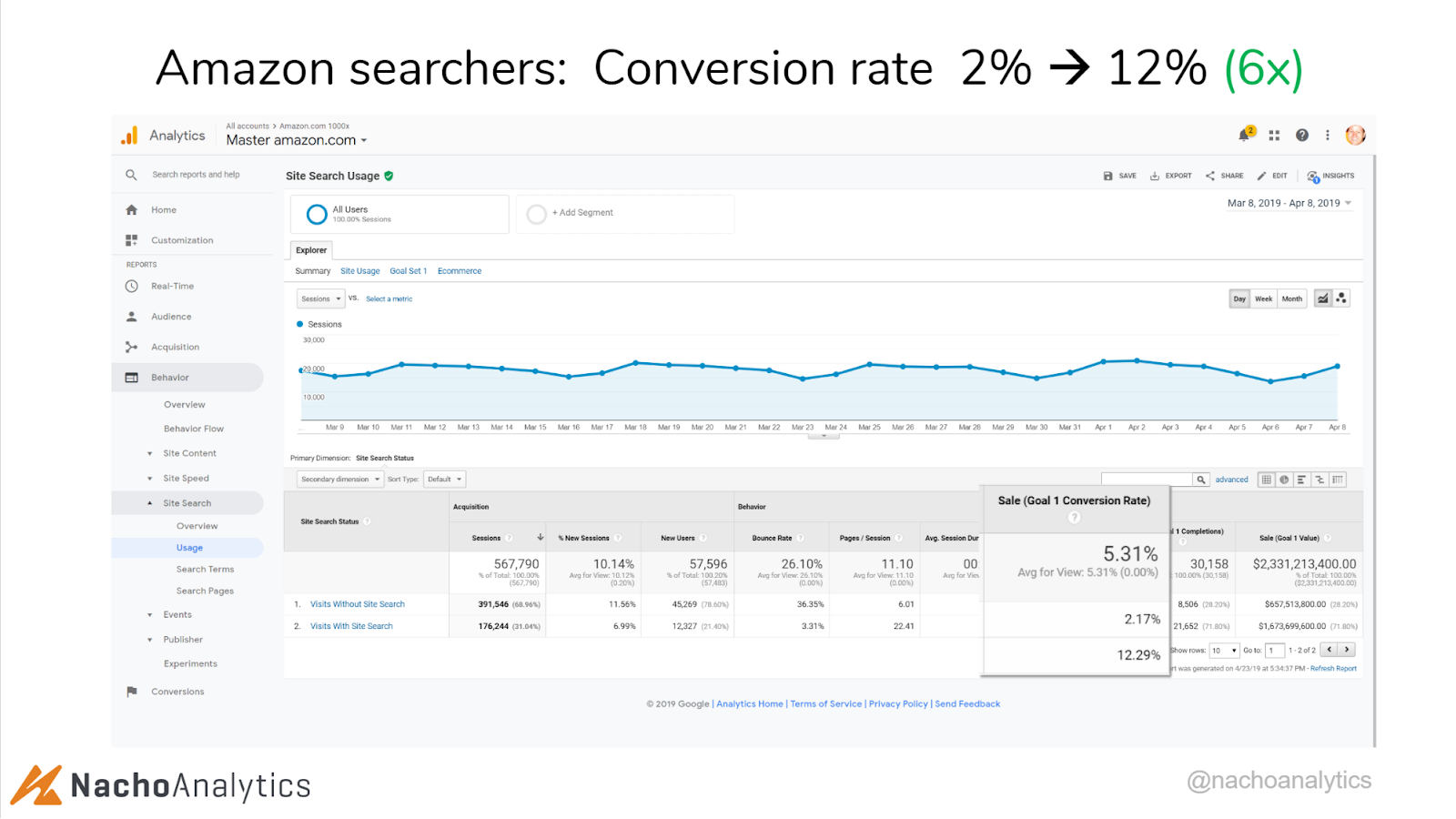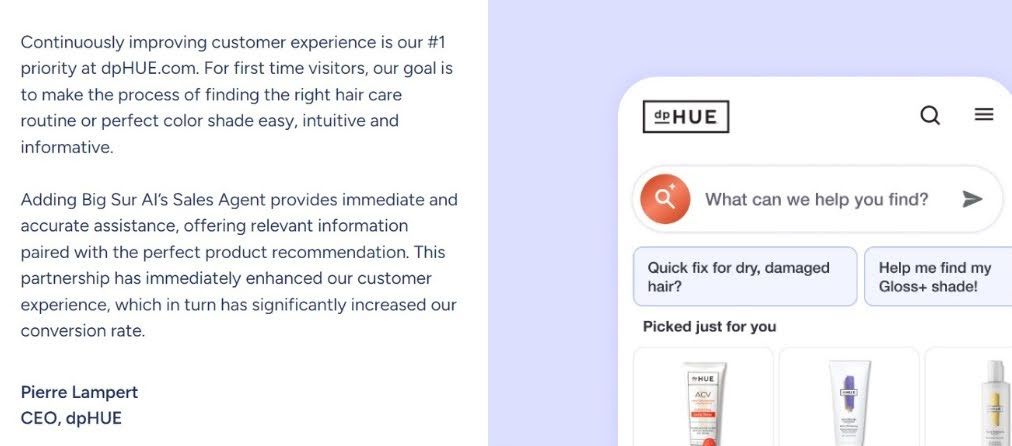Top 6 AI in Retail Examples [2025 Edition]
If you're looking for examples of AI use in retail for inspiration, then this guide is for you.
We found the 6 best case studies of incorporating AI technology in e-commerce stores.
TL;DR
- Online retailers use AI for personalization, pre-purchase and post-purchase customer support, optimizing logistics, predicting demand, and detecting fraudulent activity.
- Rad Power Bikes is increasing its conversion rates by setting up an AI-powered chatbot that can assist its customers in finding the right product for their needs.
- Raisin increased its conversion rates by 18% by personalizing its financial products to each customer.
- Sephora has developed virtual try-ons where customers can use their cameras to test their beauty products in real-time.
- Carrefour launched an AI-powered virtual assistant in France to help their customers find products with special requirements.
- Amazon has set up a personalized site search that converts 12% of the people who search.
- Using AI demand forecasting, Danone minimizes demand unpredictability and products being left on the shelves.
Let's first go over how brands are using AI technology in their online stores:
How AI is Being Used In Retail
AI is used in retail to:
- Personalize the customer experience.
- Set up a conversational chatbot.
- Optimize logistics by predicting consumer behavior.
- Detect fraudulent activity.
In this section, we'll review each use case of AI in online stores in more detail before we proceed to the case studies.
Personalize the Experience of Customers
E-commerce brands are using AI to personalize the experience of their customers with:
- Product recommendations.
- Personalized site search.
- ''Picked for you'' cross-selling and up-selling.
- Omnichannel personalization by integrating with email and social media channels.
The way retailers approach personalization with AI tools is by collecting first-party data, such as browsing habits, purchase history, and product preferences.
The AI tools then use this data to optimize product placements, rank search results based on the user's interest, and recommend relevant solutions.
According to McKinsey research, personalization programs can increase customer satisfaction by 20% and conversion rates by up to 15%.

Image from Big Sur AI's ''Picked for you'' section that considers the customer's product preferences and interactions with the website.
Set up an AI-Powered Chatbot
Online retailers are using AI chatbots to improve their customers' pre-purchase and post-purchase shopping experience.
Pre-Purchase Chatbots
You can set up a chatbot that can serve as a shopping assistant to converse with your customers to assist them in their product discovery phase.
For example, Big Sur AI's Sales Agent (our tool) is an AI-powered chatbot that re-creates the in-store shopping experience of talking to a knowledgeable salesperson.
Using Natural Language Processing (NLP), it can converse with your consumers to help them find the right product for their needs.
The software has the ability to understand search intent, so your customers can ask the chatbot to recommend a product for their use cases or compare different products:
Post-Purchase Chatbots
E-commerce brands are utilizing chatbots for customer service purposes to resolve customer issues quickly without them having to speak to a human.
Brands are saving money from not hiring human agents, and are also helping their consumers resolve their problems faster.
As a result, it has been found that AI-powered chatbots can reduce the resolution time to 5.4 minutes from 38 hours when users have to speak to a customer support agent.

Predict Customer Behavior To Optimize Logistics
One of AI's greatest uses is to analyze large amounts of data - both consumer and commercial data.
Merchants are utilizing AI-powered predictive analytics so they can:
- Optimize for seasonality and make sure they can keep the necessary products in stock.
- Make pricing decisions.
- Manage their inventory levels with better demand forecasting.
The data from these decisions is mined from their internal commercial data, first-party consumer data, and even competitor data.
According to McKinsey, AI-powered forecasts can reduce supply-chain errors by up to 50%, reducing lost sales and product unavailability by up to 65%.
AI's algorithms can analyze historical sales data, market trends, and seasonality to forecast potential sales numbers for retailers on different products.

Fraud Detection
Large e-commerce sites benefit from AI's capabilities to detect fraudulent transactions and activities on their websites.
AI technology utilizes Machine Learning (ML), Anomany Detection, and deep learning models to identify fraudulent activities on your website.
The AI-powered fraud detection systems analyze large quantities of transactional data and detect suspicious consumer patterns.
For example, the technology can detect Card Not Present (CNP) fraud that uses a stolen credit card to make a purchase online without physically presenting the card.
Traditional fraud detection methods fail to deal with this problem as the transactions look legit on the surface.
Virtual Try-Ons of Products
Large e-commerce brands like Sephora and Walmart have incorporated virtual try-ons where consumers can use their camera to see how they'd look like with clothes or makeup.
There are no fitting rooms in online stores.
But by using Augmented Reality, more and more brands are bringing a digital fitting room experience where consumers can test how products look like on them.

Later in this article, we'll go over how Sephora approached virtual try-ons and what kind of results they are getting from it.
What are the best examples of AI use in retail?
Now that we know how e-commerce brands are using AI, let's have a look at what results they are getting.
In this section we'll go over 6 case studies of online brands using AI to drive revenue, become more efficient, and personalize their customer experience at scale.
Rad Power Bikes Integrated an AI Chatbot To Help Consumers Find The Right Bike For Them
Rad Power Bikes is an online store that sells custom and affordable e-bikes.
The problem:
The store offers a wide range of e-bikes, all with different features, prices, and use cases.
In order to choose the right product for you, you'd have to be somewhat knowledgeable of e-bikes.
When shoppers go to physical stores to shop for e-bikes, they have prepared a few questions they want to ask, and the shopping assistant walks them through a few options that might be good for them.
However, in online stores, consumers had to do all of that research and make comparisons themselves.
This resulted in consumers lacking confidence in the choice they were about to make on such expensive products, decreasing conversions.
The solution:
Rad Power Bikes incorporated the AI-powered conversational chatbot Big Sur AI (that's us) to assist their customers in their product discovery process.
The brand allowed their prospective customers to:
- Ask the chatbot detailed questions about the products.
- Ask the chatbot to recommend them e-bikes according to their preferences and personal attributes (e.g., their height)
- Ask the chatbot to compare different products.
Here's how the AI Sales Agent works in the online store:
To further increase conversion rates, the tool used first-party data to create a ''Picked for you'' section in their category pages for personalized product recommendations.
Our tool also suggested types of e-bikes to consider under the site search function based on what types of e-bikes would most likely lead to a conversion for each shopper.

What happened: According to RPB's CFO, the brand saw an increase in online sales.
The brand reports that they were able to convert browsers into buyers by utilizing Big Sur AI's real-time assistance to help customers compare features and products.
Raisin Uses AI To Connect Consumers with Better Products
Raisin is a one-stop savings marketplace that operates in the retail banking industry.
The problem: More and more consumers refuse to use brick-and-mortar banks and opt for online banks.
This is the case with younger customers, as 40% of them no longer use traditional banks.
Online banks like Raisin need to step up their product and service recommendations and customer support and to understand their consumers better.
The brand wants to offer the best possible financial products to its customers so it can help them choose the right service.
The solution: Raisin adopted AI technology to understand consumer preferences of every customer - at scale.
They worked with Bloomreach and Vecton to execute an “interest rate increase auto alert” to connect customers with the financial products that best fit them.
The company was able to recommend products for their customers automatically.
The users would receive a list of products that are best for them based on the products that they visit online.
Online banks have also adopted better customer communication, as users can now text questions and receive alerts about potential fraud.

What happened: The large-scale personalization resulted in an 18% increase in conversion rate.
The brand also saw an increase in the overall customer lifetime value.
Sephora Utilizes Virtual Makeup Try-On & Skincare Advice
Sephora is a leading cosmetics and beauty retailer that sells a considerable amount of their makeup and beauty products online.
The problem: Consumers of beauty products are used to trying the makeup they are about to buy in-store to see how it looks on them.
However, they cannot do that online, so Sephora needs to find a way to provide this experience to its consumers online.
The solution: Sephora utilized AI-powered augmented reality (AR) and machine learning (ML) to create a virtual try-on tool that allows their customers to preview how their items would look on their skin.
They partnered with PulpoAR to develop a virtual try-on makeup feature that uses the customer's phone or webcam.
The AR feature can apply makeup products like eyeshadow to the customer's face in real-time, providing a realistic view of how the products would look on their skin.

As a bonus, the tool can make personalized skincare recommendations to enhance customers' shopping experience further.
What happened: Sephora received extensive media coverage as a result of this AI-powered customer experience in its store.
The brand reported a 35% increase in conversion rate, and a 25% increase in add-to-basket rate.
Carrefour Uses an AI Chatbot to Improve Customer Experience in France
Carrefour is a supermarket that has an online store where you can buy most consumer products - from groceries to electronics.
The problem: As a website that has tens of thousands of products in their online store, it can be daunting for users to find what they are looking for.
The brand has also identified that customers are struggling to choose products that meet their dietary requirements and budgets.
Normally, they could ask an in-store assistant to help them with that, but they could not do that on their website.
The solution: Carrefour decided to run a test in France by utilizing Hopla, an AI-powered conversational chatbot.
The chatbot uses ChatGPT technology to offer real-time product suggestions, which can be based on customers' budgets and dietary preferences.

The store was able to turn their website from a large catalogue of products to a more engaging and user-centric experience.
What happened: Even though Carrefour has not shared the results of their AI chatbot in France, they've decided to further pursue the idea of Gen AI.
Their CEO, Alexandre Bompard, mentions that Carrefour will continue using Generative AI to enrich their customers' experience and transform the way the businesses operates.
The company was so satisfied with Generative AI's capabilities, that they are now reportedly using it internally for their procurement processes.
Amazon Personalized Their Site Search with AI
As the largest online retailer, Amazon is constantly on the look for innovation and ways of improving their conversion rates from the millions of people who visit their website daily.
The problem: 79% of consumers visit Amazon to begin their search for products in the US.
That meant they could not afford to have a search engine that is only matching keywords to titles.
To keep their customers from returning to them day after day, they needed to find a way to show customers the best product results when they search.
The solution: Amazon utilized advanced machine learning algorithms and AI to analyze first-party consumer data so they can make personalized product recommendations when people use their search function.
Their engine takes into consideration the users':
- Past purchases.
- Interactions with their services.
- Interactions with their products (e.g., what you watched on Prime Video).
After collecting all of this first-party data, the tool uses AI-powered analytics and algorithms to recommend products that the customer is most likely to be interested in.
Amazon can also customize its homepage for each of its customers based on this data based on their purchasing behavior, products added to cart, and wish lists.

What happened: Amazon now converts 12.29% of their visitors when they perform a search.
This is a 6x increase when compared to 2.19% when consumers do not perform a search.

Danone Demand Forecasting & Supply Chain Optimization
Danone is a French manufacturer that is one of the giants in the food industry.
The problem: Large retailers face demand volatility, so some of their products inevitably expire.
There are many factors that influence product demand, such as social media and current trends.
Danone needed a way to predict consumer demand as accurately as possible so it could optimize its supply chain.
Moreover, the brand was aware that it makes 30% of its revenue from promotional offers, which is why it needed to find a way to improve its planning for them.
The solution: The company implemented an AI-powered machine learning system to make better product demand forecasts.
That system also improved the internal planning between their supply chain and marketing teams, creating more efficient promotional campaigns.
The way they did it is that they implemented ToolsGroup's machine learning solution to identify how promotional and media events affect their sales.
Danone was able to create an efficient planning coordination by predicting demand variability and planning.

What happened: Danone is now able to achieve its target service levels for channel or store-level inventories.
The brand reported a 20% reduction in forecast error, 30% reduction in lost sales, and a 10 point ROI improvement in their promotions.
What are the best AI tools for E-Commerce?
Now that we've shown the results online retailers are getting from AI tools, you can check out our updated guide of the 10 best AI tools for e-commerce in 2025.
Conclusion
Large brands have incorporated AI technologies into their operational workflows and on-site experience for years.
Many brands did not have access to these tools, as they were largely custom build in-house or by consultants.
But now things have changed with the emergence of the latest AI tools.
The average retailer can now access predictive analytics, AI-powered site search, and conversational chatbots.
As a result, 78% of e-commerce brands have already implemented AI technology into their e-commerce stores or are planning to do so.
Not sure where to start with AI?
The best way to start with AI technology is to look for tools that can generate a positive return on investment.
💡Users who interact with our AI-powered chatbot convert at 4x the rate of the average store user.


